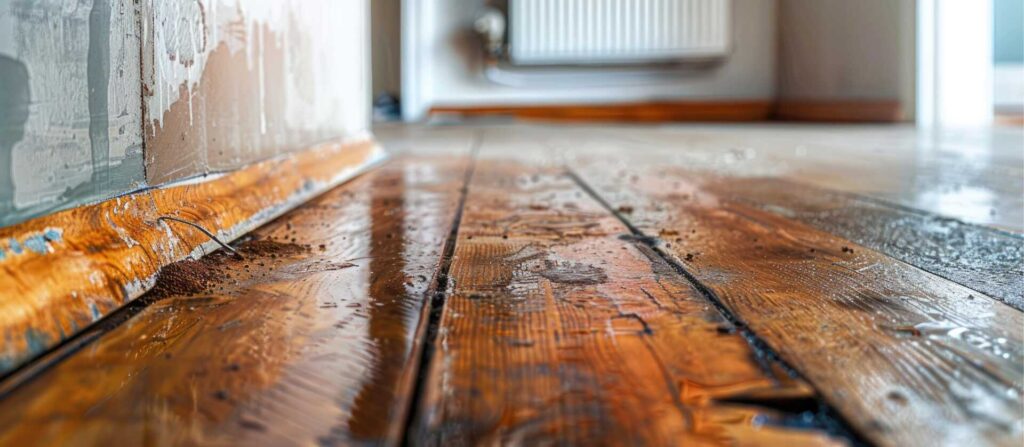
Contents
When it comes to handling post-water damage sewage cleanup, ensuring your safety and effectively addressing the aftermath is essential. From initial assessments to thorough disinfection, each step plays an important role in the restoration process. By following industry best practices, you can not merely mitigate the current damage but also prevent potential issues down the line. Stay tuned as we explore the key strategies and methods to navigate through this challenging situation with expertise and precision.
Key Takeaways
- Prioritize safety with protective gear.
- Extract water thoroughly before drying.
- Disinfect and sanitize all affected areas.
- Repair structural damage promptly.
- Monitor for mold growth and prevent recurrence.
Initial Assessment and Safety Precautions
During the initial evaluation of post-water damage sewage cleanup, it’s vital to prioritize safety precautions to prevent any health hazards or further damage. When dealing with contaminated materials from sewage backup, swift action is essential to mitigate health risks and guarantee a thorough cleanup process.
Begin by evaluating the extent of the water damage and identifying any areas where sewage water has intruded. Pay close attention to spaces like basements, crawl spaces, and areas with poor ventilation, as these are prone to retaining moisture and fostering mold growth.
Next, equip yourself with personal protective gear such as gloves, masks, and boots to shield against potential contaminants present in sewage water. Keep in mind that sewage backup contains harmful bacteria, viruses, and other pathogens that pose serious health risks if not handled properly.
It’s imperative to properly dispose of any porous materials that have come into contact with sewage water, as they may be impossible to fully sanitize.
Furthermore, guarantee adequate ventilation in the affected area to facilitate drying and prevent the buildup of mold. Use disinfectants and antimicrobial solutions to sanitize surfaces and prevent microbial growth.
Remember to wash your hands thoroughly after handling contaminated materials to avoid spreading harmful pathogens. By adhering to these safety precautions during the initial evaluation, you can effectively manage the post-water damage sewage cleanup process and safeguard both your health and the integrity of the affected space.
Water Extraction and Drying Process
To effectively address the water extraction and drying process after sewage backup, your primary focus should be on swiftly removing excess water from the affected area.
The first step is selecting the right equipment for the job. Industrial-grade wet vacuums, pumps, and dehumidifiers are important tools for efficient water extraction and drying. Wet vacuums can quickly remove standing water, while pumps are useful for larger quantities of water. Dehumidifiers help to reduce moisture levels in the air, aiding in the drying process.
If the water damage is extensive, it may be best to enlist professional services. Water damage restoration companies have the expertise and specialized equipment to handle sewage backup cleanup effectively. They can assess the extent of the damage, determine the best course of action, and guarantee thorough water extraction and drying.
When using equipment for water extraction, make sure to follow safety guidelines and wear appropriate protective gear.
Begin by extracting as much water as possible before moving on to the drying phase. Proper ventilation is vital during the drying process to prevent mold growth. Monitor the drying progress regularly and adjust the equipment as needed until the affected area is completely dry.
Disinfection and Sanitization Procedures
Implementing effective disinfection and sanitization procedures is fundamental in the aftermath of water damage caused by sewage backup. Sewage contamination poses a serious health risk due to the presence of pathogens and harmful bacteria. To combat this, thorough cleaning and disinfection are imperative steps in restoring a safe environment.
Start by wearing appropriate personal protective equipment, such as gloves, masks, and goggles, to protect yourself from exposure to sewage contaminants. Remove any visible debris or sewage-soaked materials, disposing of them properly. Clean and sanitize all affected surfaces using a mixture of water and a disinfectant approved for killing bacteria and viruses.
Pay special attention to areas with high levels of contamination, such as bathrooms and kitchens. After cleaning, guarantee proper ventilation to aid in drying out the space and preventing microbial growth. Use fans and dehumidifiers to speed up the drying process.
Inspect for any signs of mold or mildew and address them promptly. Remember to disinfect not just surfaces but also any furniture, belongings, and personal items that may have come into contact with sewage-contaminated water.
Following these disinfection and sanitization procedures diligently will help mitigate health risks and prevent further damage from sewage contamination and microbial growth.
Structural Repair and Restoration
Now, as you move forward in the restoration process, attention to the structural repair and restoration of the affected areas is paramount. Confirming the structural integrity of the building post-water damage is essential to prevent any further issues.
One key aspect of structural repair is addressing any mold growth that may have occurred due to the water damage. Mold remediation should be conducted following industry best practices to eliminate any potential health hazards and prevent future mold growth.
When it comes to structural restoration, it’s important to assess the extent of the damage thoroughly. This includes inspecting walls, ceilings, floors, and other structural elements for any signs of weakening or deterioration.
Any compromised areas should be promptly repaired or replaced to restore the structural integrity of the building. Ignoring structural issues can lead to more significant problems down the line, such as collapses or further water damage.
To guarantee that the structural repair and restoration are done effectively, it’s recommended to consult with professionals experienced in handling water damage situations. They can provide expert guidance on the best course of action to take and confirm that the structural integrity of the building is fully restored.
Follow-Up Inspection and Preventive Measures
Conducting a follow-up inspection after water damage restoration is vital for guaranteeing the effectiveness of the cleanup and repair efforts.
Mold prevention and addressing health risks are significant aspects of this phase. Here are some key points to take into account during the follow-up inspection and preventive measures:
Inspect for Mold Growth: Check for any signs of mold growth, especially in hidden or hard-to-reach areas.
Guarantee Proper Ventilation: Proper ventilation is essential to prevent moisture buildup, which can lead to mold growth.
Monitor Humidity Levels: Use a hygrometer to monitor humidity levels and guarantee they remain below 60% to discourage mold growth.
Check for Water Leaks: Inspect plumbing fixtures, pipes, and the roof for any water leaks that could lead to future water damage.
Educate Occupants: Inform occupants about the importance of reporting water leaks promptly and maintaining a dry environment to prevent health risks associated with mold.
Recap
In summary, remember the old adage “an ounce of prevention is worth a pound of cure” when it comes to post-water damage sewage cleanup. By following best practices, prioritizing safety, thoroughness, and prevention, you can guarantee a successful restoration process. Stay vigilant, stay informed, and be proactive in addressing any potential water damage issues to keep your property safe and secure for years to come.
Recent Posts
5 Tips for Inexpensive Leak Detection Services
It is important to promptly address any water leaks, but you don’t have to break
Mastering Biohazard Sewage Cleanup Techniques
Is it really worth the risk to tackle biohazard sewage cleanup without the right techniques?
Top Leak Detection Services for Homeowners
Is it true that most homeowners underestimate the impact of undetected leaks? You might think

